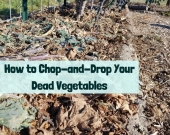
 11
11







Cultivate abundance for people, plants and wildlife - Growing with Nature



 5
5




Visit Redhawk's soil series: https://permies.com/wiki/redhawk-soil
How permies.com works: https://permies.com/wiki/34193/permies-works-links-threads
First comment on the blog post! Thank you! Pie for you! 




Jay Angler wrote:I've just been reading, "the soil will save us - how scientists, farmers, and foodies are healing the soil to save the planet" by Kristin Ohlson. In Chapter 4 she gives an example of an American farmer who plants fields of polycultures as animal and human forage where the tallest plant is a sunflower. Having done this for about 15 years now, he can push a moisture meter easily down 4 ft. That's an example of how deeply we can get water infiltrating if we heal the soil through simple techniques such as no-till, cover-crops, and planting a wide variety of plants. An interesting byproduct of his management was that the insect quantity and variability has sky-rocketed. These insects are in balance with the plants - the farmer uses no insecticides, and the insects actually eat many weed seeds, keeping less desirable plants under control. These are things people can do even on urban yards to conserve water. Planting bulbs and deep rooted flowers is a great first step in a location where things need to look "neat".
Cultivate abundance for people, plants and wildlife - Growing with Nature







Visit Redhawk's soil series: https://permies.com/wiki/redhawk-soil
How permies.com works: https://permies.com/wiki/34193/permies-works-links-threads




Community Building 2.0: ask me about drL, the rotational-mob-grazing format for human interactions.
 1
1




Visit Redhawk's soil series: https://permies.com/wiki/redhawk-soil
How permies.com works: https://permies.com/wiki/34193/permies-works-links-threads
 2
2




 3
3




 1
1




Still able to dream.

 1
1




 2
2








Invasive plants are Earth's way of insisting we notice her medicines. Stephen Herrod Buhner
Everyone learns what works by learning what doesn't work. Stephen Herrod Buhner
 3
3




I think managing mosquitos with a multi-year attitude could be good. Yes, apparently duckweed covering the surface seems to discourage mosquitos, at least where I live. Here it sinks into the pond in winter, and floats back up in spring, but I have no idea how cold it tolerates.However, my concern is exactly what was flagged but not completely dealt with: *mosquitos.*
Visit Redhawk's soil series: https://permies.com/wiki/redhawk-soil
How permies.com works: https://permies.com/wiki/34193/permies-works-links-threads




Jay Angler wrote:
I also have a couple of Maximillian sunflower patches. In really long droughts they don't flower for me, but they don't get any supplemental water and haven't died, so that's saying a lot in my books! That said, they're only spreading extremely slowly, and they're quite thin and small. Things I'd read suggested they'd grow thickly enough to discourage/redirect deer, but that's definitely not happening in my eco-system.
Best luck: satisfaction
Greatest curse, greed




Alas, they're not dead, but they're definitely not thriving in my ecosystem. I think we just don't get the summer heat they like, and they're not in a place I water, although I have repeatedly added mulch and chopped and dropped the area. We're on rocky clay over sedimentary bedrock that's been folded, so I never know where it will be on the surface, 6" under, or 3 feet under. It's on my list to dig up down slope of where they're planted. If I can break up whatever's there, remove some big rocks, and plants some punky wood, I suspect the pear tree, the plum tree, and the sunflowers will all be happier. The occasional year they've blossomed late in the fall, but they blooms have tended to go moldy from the heavy dew before the seeds have been ready to harvest, so I haven't really been able to try to create any sort of landrace either.Thekla McDaniels wrote:How are the Maximilian sunflowers doing, Jay?
They’re a favorite of mine. I’ll be planting a row of them as deer discouragers here in my new place. Interesting to me is the fact that the deer leave them alone, but my goats like them.
Visit Redhawk's soil series: https://permies.com/wiki/redhawk-soil
How permies.com works: https://permies.com/wiki/34193/permies-works-links-threads




Best luck: satisfaction
Greatest curse, greed
 1
1




This was strictly an observation - we have long summer days, so I wouldn't think it was lack of sun hours. I have trouble getting tomatoes to ripen, which seem to need 10 more degrees than I reliably get even though I have more hours of sun than my sister in Ontario who gets lots of ripe tomatoes. I may actually have that backwards - we cool off a *lot* at night due to the "ocean on-shore breeze", so maybe they don't like our lows and need it warmer to trigger "fruit set". I've been told that pepper plants have an ideal "day heat vs night low" parameter for setting fruit, so such things exist. Humans are just so good about moving plants around to select for ones we think are helpful!Thekla McDaniels wrote:I didn’t know they had a heat requirement, but where I used to be, and had them , July was always hot
Visit Redhawk's soil series: https://permies.com/wiki/redhawk-soil
How permies.com works: https://permies.com/wiki/34193/permies-works-links-threads
 2
2




Best luck: satisfaction
Greatest curse, greed

|
I'm not dead! I feel happy! I'd like to go for a walk! I'll even read a tiny ad:
permaculture and gardener gifts (stocking stuffers?)
https://permies.com/wiki/permaculture-gifts-stocking-stuffers
|









